Rainloop is a free Open Source web application written in PHP which provides a fast modern web interface to access your emails on all major domain mail providers like Yahoo, Gmail, Outlook and many others as well as your own local mail servers, and, also, acts as a MUA (Mail User Agent) by accessing domain mail servers through IMAP and SMTP protocols.
RainLoop Demo
Have a quick look at the demo page setup by the author at http://demo.rainloop.net/.
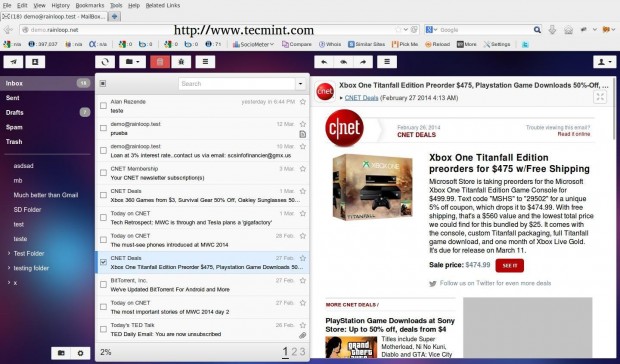
Once you have deployed Rainloop on your servers the only thing remaining to do is to access your Rainloop domain through a web browser and provide credentials for your enabled domain mail server.
This tutorial covers Rainloop webmail installation process on Arch Linux from both point of view configuration files for Apache and Nginx, using a virtual local domain configured through local hosts file, without a DNS server.
If you also need references on installing Rainloop on Debian and Red Hat systems visit the previous RainLoop Webmail article at.
Requirements
For Nginx
- Install LEMP (Nginx, PHP, MySQL with MariaDB engine and PhpMyAdmin) in Arch Linux
- Create Virtual Hosts in Nginx Web Server
For Apache
Step 1: Create Virtual Hosts for Nginx or Apache
1. Assuming that you have configured your servers (Nginx or Apache) as described in upper presentations links, the first thing you need to do is to create a rudimentary DNS entry on local hosts file that points to Arch Linux system IP.
On Linux system edit /etc/hosts file and include your Rainloop virtual domain after localhost entry.
127.0.0.1 localhost.localdomain localhost rainloop.lan 192.168.1.33 rainloop.lan
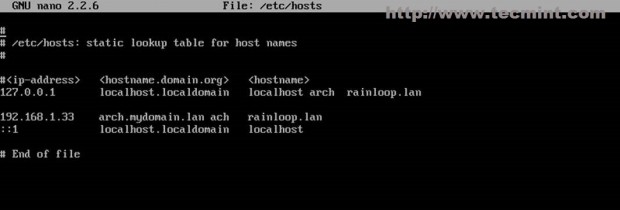
On Windows system edit C:\Windows\System32\drivers\etc\hosts and add the following line at the bottom.
192.168.1.33 rainloop.lan
2. After you verify local domain using ping command, create the necessary Virtual Hosts and SSL configurations for Apache or Nginx.
Nginx Virtual Hosts
Create a file named rainloop.lan in /etc/nginx/sites-available/ path with the following configuration.
$ sudo nano /etc/nginx/sites-available/rainloop.conf
Add the following file content.
server {
listen 80;
server_name rainloop.lan;
rewrite ^ https://$server_name$request_uri? permanent;
access_log /var/log/nginx/rainloop.lan.access.log;
error_log /var/log/nginx/rainloop.lan.error.log;
root /srv/www/rainloop/;
# serve static files
location ~ ^/(images|javascript|js|css|flash|media|static)/ {
root /srv/www/rainloop/;
expires 30d;
}
location / {
index index.html index.htm index.php;
autoindex on;
autoindex_exact_size off;
autoindex_localtime on;
}
location ^~ /data {
deny all;
}
location ~ \.php$ {
#fastcgi_pass 127.0.0.1:9000; (depending on your php-fpm socket configuration)
fastcgi_pass unix:/run/php-fpm/php-fpm.sock;
fastcgi_index index.php;
include fastcgi.conf;
}
}
Then create the SSL equivalent file content.
$ sudo nano /etc/nginx/sites-available/rainloop-ssl.conf
Add the following file content.
server {
listen 443 ssl;
server_name rainloop.lan;
ssl_certificate /etc/nginx/ssl/rainloop.lan.crt;
ssl_certificate_key /etc/nginx/ssl/rainloop.lan.key;
ssl_session_cache shared:SSL:1m;
ssl_session_timeout 5m;
ssl_ciphers HIGH:!aNULL:!MD5;
ssl_prefer_server_ciphers on;
access_log /var/log/nginx/rainloop.lan.access.log;
error_log /var/log/nginx/rainloop.lan.error.log;
root /srv/www/rainloop/;
# serve static files
location ~ ^/(images|javascript|js|css|flash|media|static)/ {
root /srv/www/rainloop/;
expires 30d;
}
location ^~ /data {
deny all;
}
location / {
index index.html index.htm index.php;
autoindex on;
autoindex_exact_size off;
autoindex_localtime on;
}
location ~ \.php$ {
#fastcgi_pass 127.0.0.1:9000; (depending on your php-fpm socket configuration)
fastcgi_pass unix:/run/php-fpm/php-fpm.sock;
fastcgi_index index.php;
include fastcgi.conf;
}
}
On the next step generate Certificate file and Keys for SSL Virtual Host and add your virtual domain name (rainloop.lan) on Certificate Common Name.
$ sudo nginx_gen_ssl.sh
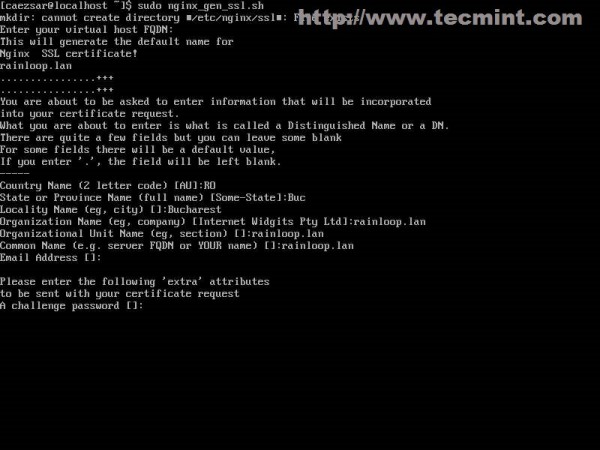
After the Certificate and SSL keys are generated, create Rainloop root webserver file path ( place where Rainloop PHP files reside), then enable Virtual Hosts and restart Nginx daemon to apply configurations.
$ sudo mkdir -p /srv/www/rainloop $ sudo n2ensite rainloop $ sudo n2ensite rainloop-ssl $ sudo systemctl restart nginx

Apache Virtual Hosts
Create a new file named rainloop.conf in /etc/httpd/conf/sites-available/ with the following content.
$ sudo nano /etc/httpd/conf/sites-available/rainloop.conf
Add the following file content.
<VirtualHost *:80>
ServerName rainloop.lan
DocumentRoot "/srv/www/rainloop/"
ServerAdmin [email protected]
ErrorLog "/var/log/httpd/rainloop-error_log"
TransferLog "/var/log/httpd/rainloop-access_log"
<Directory />
Options +Indexes +FollowSymLinks +ExecCGI
AllowOverride All
Order deny,allow
Allow from all
Require all granted
</Directory>
</VirtualHost>
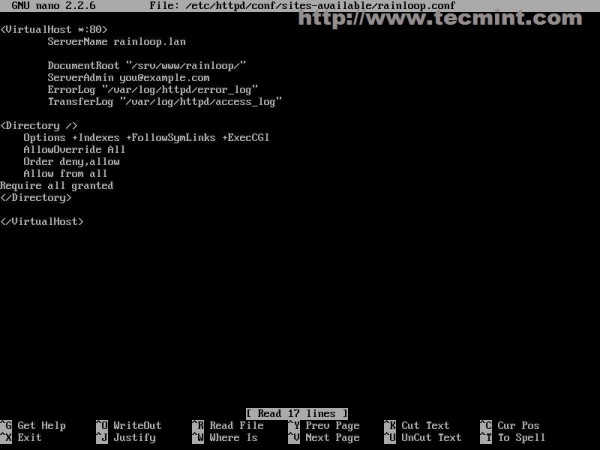
Then create the SSL equivalent file content for Apache.
$ sudo nano /etc/httpd/conf/sites-available/rainloop-ssl.conf
Add the following file content.
<VirtualHost *:443>
ServerName rainloop.lan
DocumentRoot "/srv/www/rainloop/"
ServerAdmin [email protected]
ErrorLog "/var/log/httpd/rainloop-ssl-error_log"
TransferLog "/var/log/httpd/rainloop-ssl-access_log"
SSLEngine on
SSLCertificateFile "/etc/httpd/conf/ssl/rainloop.lan.crt"
SSLCertificateKeyFile "/etc/httpd/conf/ssl/rainloop.lan.key"
<FilesMatch "\.(cgi|shtml|phtml|php)$">
SSLOptions +StdEnvVars
</FilesMatch>
BrowserMatch "MSIE [2-5]" \
nokeepalive ssl-unclean-shutdown \
downgrade-1.0 force-response-1.0
CustomLog "/var/log/httpd/ssl_request_log" \
"%t %h %{SSL_PROTOCOL}x %{SSL_CIPHER}x \"%r\" %b"
<Directory />
Options +Indexes +FollowSymLinks +ExecCGI
AllowOverride All
Order deny,allow
Allow from all
Require all granted
</Directory>
</VirtualHost>
The next step is to create SSL Certificate file and Keys for SSL Virtual Host and add put your virtual domain name (rainloop.lan) on Certificate Common Name.
$ sudo apache_gen_ssl
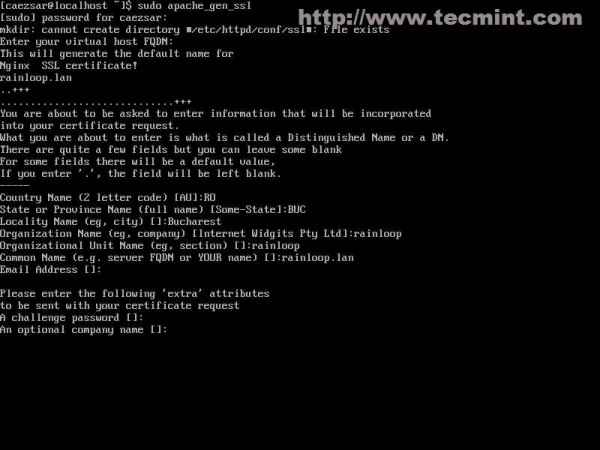
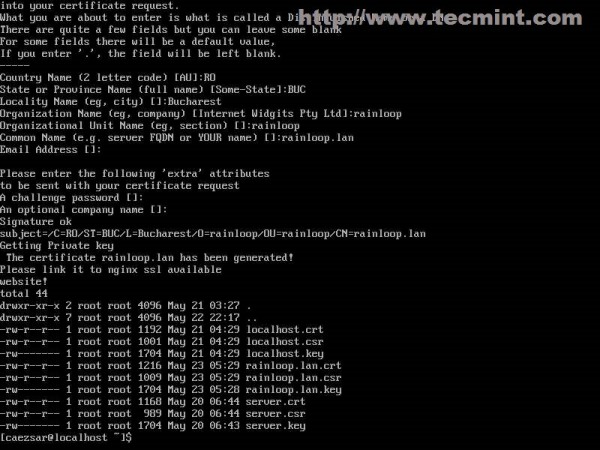
After the Certificate and SSL keys are created, add Rainloop DocumentRoot path, then enable Virtual Hosts and restart Apache daemon to apply configurations.
$ sudo mkdir -p /srv/www/rainloop $ sudo a2ensite rainloop $ sudo a2ensite rainloop-ssl $ sudo systemctl restart httpd

Step 2: Add necessary PHP Extensions
3. Whether you are using Apache or Nginx webserver, you need to enable the following PHP extensions on php.ini file and, also, include the new webserver DocumentRoot path to open_basedir directive.
$ sudo nano /etc/php/php.ini
Locate and uncomment the following PHP extensions.
extension=iconv.so extension=imap.so extension=mcrypt.so extension=mssql.so extension=mysqli.so extension=openssl.so ( enables IMAPS and SMTP SSL protocols on mail servers) extension=pdo_mysql.so
Also open_basedir statement should look like this.
open_basedir = /srv/http/:/home/:/tmp/:/usr/share/pear/:/usr/share/webapps/:/etc/webapps/:/srv/www/
4. After the php.ini file was modified restart your server than check phpinfo file to see if SSL protocols are enabled.
----------On Apache Web Server---------- $ sudo systemctl restart httpd
----------On Nginx Web Server---------- $ sudo systemctl restart nginx $ sudo systemctl restart php-fpm
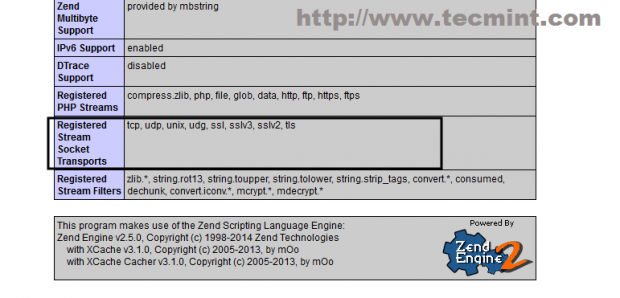
Step 3: Download and Install RainLoop Webmail
5. Now it’s time to download and extract Rainloop application from official website to Document Root directory but first install wget and unzip system utilities.
$ sudo pacman -S unzip wget
6. Download latest source package Rainloop zip archive using wget command or by using a browser to navigate to http://rainloop.net/downloads/.
$ wget http://repository.rainloop.net/v1/rainloop-latest.zip

7. After the download process finishes, extract Rainloop archive to Virtual Host Document Root path ( /srv/www/rainloop/ ).
$ sudo unzip rainloop-latest.zip -d /srv/www/rainloop/
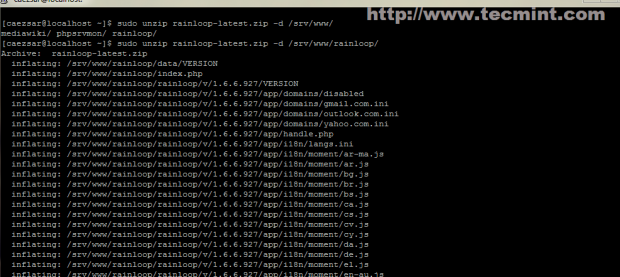
8. Then set the following permissions on application default path.
$ sudo chmod -R 755 /srv/www/rainloop/ $ sudo chown -R http:http /srv/www/rainloop/
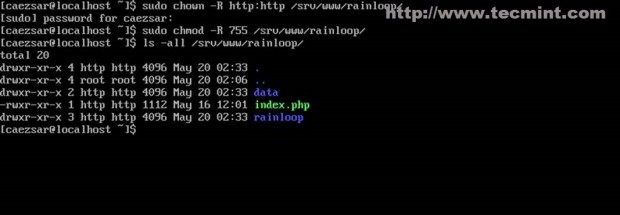
Step 4: Configure Rainloop via Web Interface
9. Rainloop application can be configured in two ways: using a system shell of via browser. If you want to configure over terminal open and edit application.ini file located in /srv/www/rainloop/data/_data_da047852f16d2bc7352b24240a2f1599/_default_/configs/.
10. To access Admin Interface from browser, use the following URL address https://rainloop.lan/?admin, then provide the default application credentials.
User= admin Password= 12345
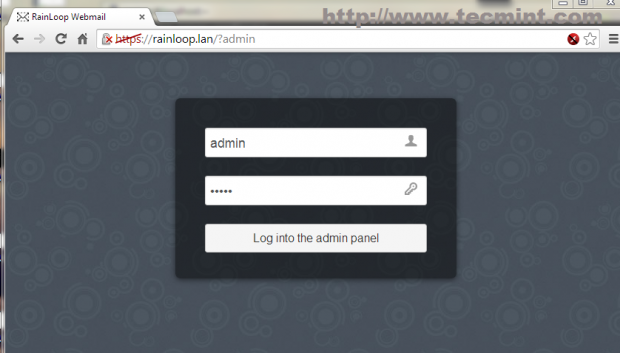
11. After initial login you will be warn to change the default password, so I advise you to do it.
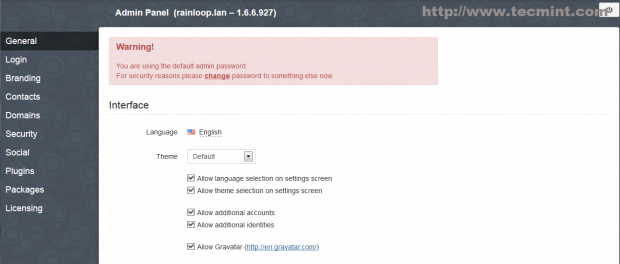
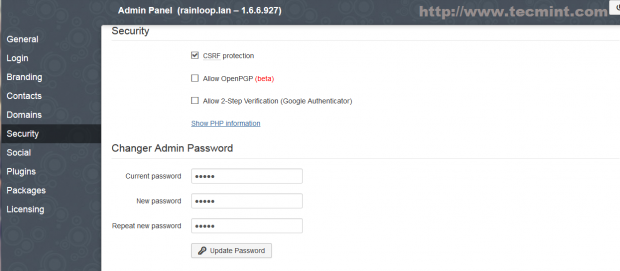
12. If you want to enable contacts login to MySQL database and create a new database with a privileged user on it, then provide database credentials on Contacts fields.
mysql -u root -p create database if not exists rainloop; create user rainloop_user@localhost identified by “password”; grant all privileges on rainloop.* to rainloop_user@localhost; flush privileges; exit;
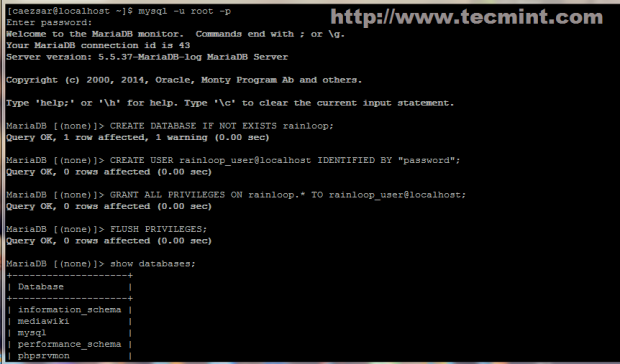
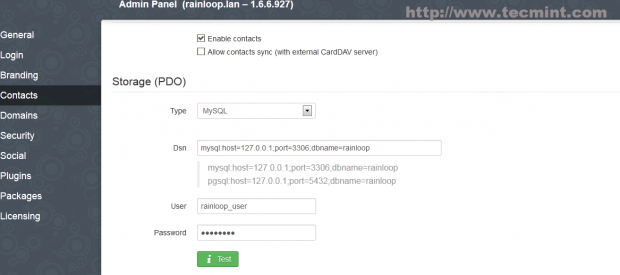
13. By default Rainloop provides Gmail, Yahoo and Outlook domains mail server configuration files, but you can add other mail server domains if you like.
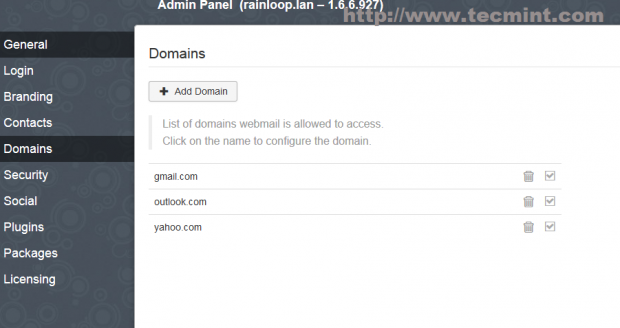
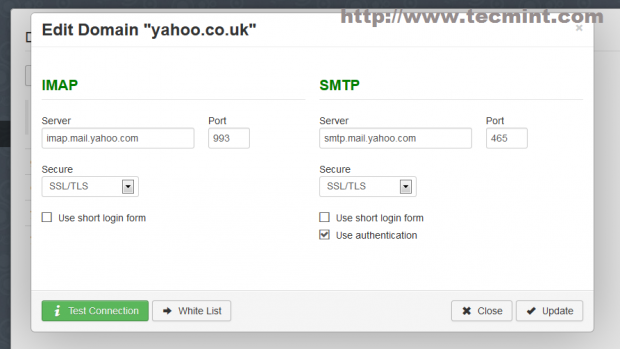
14. To login on your mail server point your browser to https://rainloop.lan and provide your domain server credentials.
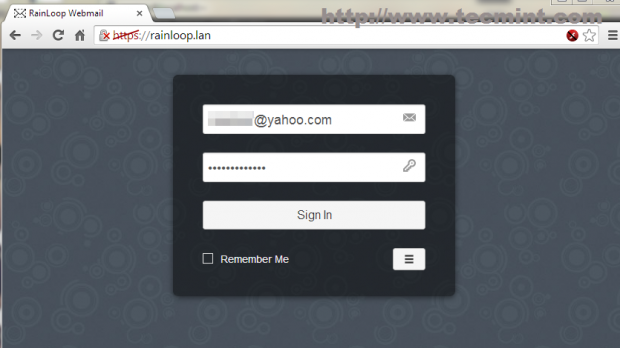
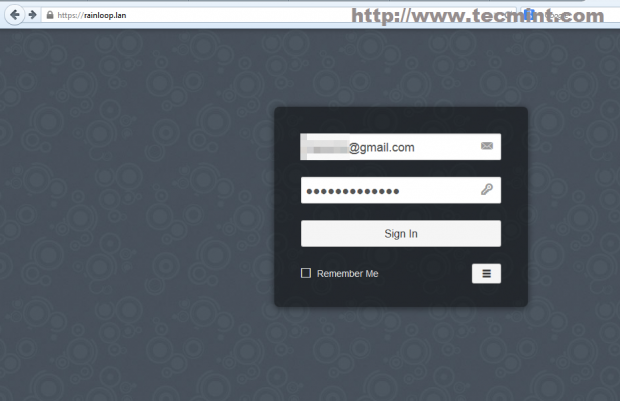
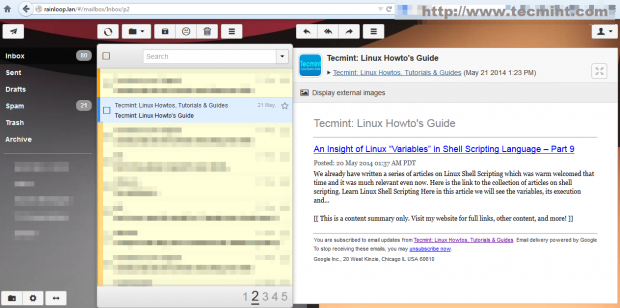
For further configurations please visit official Rainloop documentation page at http://rainloop.net/docs/.
With Rainloop you can access mail servers from any device that has a browser as long as your server has Internet connectivity, the only minus of using Rainloop application in Arch Linux so far is the lack of poppassd plugin package needed to change email account password.






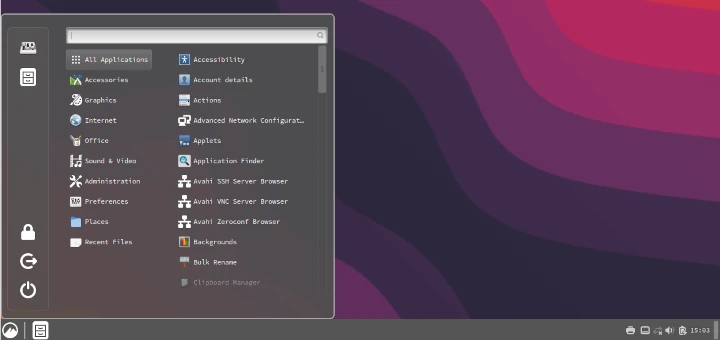
Wow, not too sure what the author was on when writing those Apache config files up above? They bear no relationship to anything I know of or have ever come across recently.
I mean, I don’t mind a challenge but, whatever’s in there is certainly mind bending. Doesn’t quite add anything to Tecmint’s credibility and expertise on this topic. While this piece was written some time back, don’t believe things have changed that much? Maybe time to research, review and update this article.
Yes. I have plenty to say. We just moved over to RainLoop webmail hosting. I’m trying to see how to retrieve all of my folders that RainLoop won’t allow me to have! It won’t even let me delete folders that I no longer need.
I sent an email out last week requesting assistance, and I never got a response. Is there anyone out here in the RainLoop cyber dimension that is willing to get in touch with me so that I can resolve this issue????
What kind of folders are you talking about?
Verify your accounts credentials.
please how do you do that… l have created the Imap and smtp connections for yahoo and gmail enabled app connection to connect with gmail but still the same… can login on the yahoo or gmail platform but now when using rainloop
Check the firewall policy. Maybe some rules block your requests.
l keep getting authentication failed trying to login with yahoo, or gmail
Does it support PGP signatures/encryption?